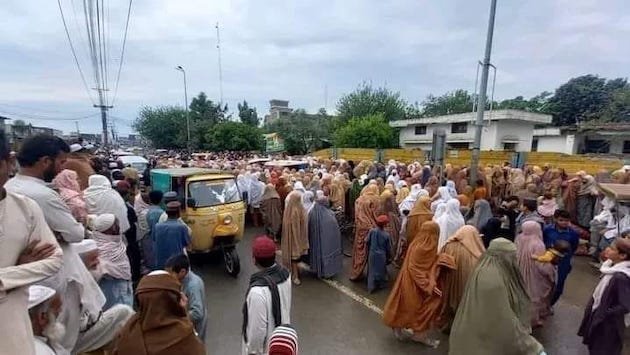PESHAWAR, Mar 29 (IPS) – The free Atta (flour) distribution scheme launched by the government to assist the inflation-hit communities during the holy month of Ramzan has left at least ten dead and over 100 injured as would-be beneficiaries rush to claim their 10-kilogram bags.
“We have been waiting in long queues to get a bag of flour since morning but to no avail, as the police resorted to baton charging the would-be beneficiaries. At least 20 people, including seven women, sustained injuries because police baton-charged the crowd,” Abdul Wali, 35, a daily wager, told IPS.
A resident of Mardan district in Khyber Pakhtunkhwa (KP), Wali said that he had no money to purchase flour and other items for daily use and had pinned his hopes on the free flour scheme. But owing to the rush of people, he didn’t get it. Instead, the injured man was rushed to the hospital.
Wali, a street vendor, said he received first aid at the hospital, where his wounds were bandaged, but he has been forced to rest until he recovers.
On March 8, Prime Minister Shehbaz Sharif announced the government would provide 100 million people with 10kg of free flour during Ramzan in Punjab and Khyber Pakhtunkhwa (KP) provinces. He said it would cost Rs73 billion (about USD 257 million) to the national exchequer.
Since the beginning of flour distribution at the designated points, ten people, including two women, have died in their effort to get free bags under the Benazir Income Support Programme (BISP).
Pakistanis, hit by price-hikes, rush to the points each day, but half of them return empty-handed in the evening due to the number of people trying to claim their food parcels. Stampedes have a problem, especially in KP, where the poverty ratio is higher than in any other province.
“My father stood in a row to get the flour, but meanwhile, stampede started, and he died instantly,” Ghufran Khan, a daily wager in Charsadda district, told IPS. His father, Wakil Khan, 55, an asthmatic, lost his life before he could get his flour ration.
Mismanagement at the distribution places is keeping the elderly and sick people away from points where the young and healthy people get the flour, he said.
On March 26, a tribal Jirga banned women from visiting the distribution points in Bara Khyber District in KP.
“Our women are getting harsh treatment, and therefore, we have decided that only male members of the deserving families would collect the bags,” Shahid Khan Shinwari, a member of the Jirga, said.
According to him, the government should give cash amounts through banks to avoid maltreatment of the beneficiaries.
“As per local traditions, our women don’t venture out in public, but poverty has hit the people hard, forcing them even to resort to begging. Government should take pity on poor people who have no option but to wait in the scorching sun to get flour,” Shinwari said.
The situation in tribal districts located along the Pakistan-Afghanistan border is very precarious because of the poverty, he said.

Nasreen Bibi, a resident of Peshawar, the capital of KP, is angry about the distribution mechanism.
“For the last three days, I have been visiting the point, but there was no chance of getting the stuff due to the massive crowd. I am scared and have stopped going there now,” Bibi, a housewife, told IPS. A widow, she has to feed her six children. All are unemployed, and her oldest son, a mason, lost his job because the construction activities have come to a complete halt due to Ramzan, she said.
Young people are climbing over trucks loaded with flour and take away bags while the women are forced to be silent spectators, she explained.
Sharif visited several cities after reports of deaths and injuries, but there has been no improvement as the mechanism is problematic. On March 27, he inspected several places in Islamabad, but there have been no improvements so far.
Human rights activists are concerned.
“It is a gross violation of human rights. People are fighting for flour without caring for their well-being and health. I recommend that the government adopt the mechanism of former Prime Minister Imran Khan during Covid-19, where people received Rs12,000 through banks,” Muhammad Uzair, a human rights activist, said.
On rainy days, the situation worsens when the people get wet flour that cannot be used, he said.
“We appeal to the government to realize the gravity of the situation and revert to cash assistance to save the women, children and elderly people from disrespect,” he said.
He said that if the government didn’t pay attention, the crisis may increase, and many people could lose their lives.
Even in Islamabad, the capital city of Pakistan, people throng the distribution points early in the morning, but many lose hope and return to their homes.
“The government has enrolled 150,000 families in Islamabad, but the pace of distribution is at snail’s pace, and police have had to intervene time and again to ensure order,” Shah Afzal, 59, said.
Afzal, a dishwasher in a restaurant, lost his job during Ramzan. He said the flour distribution gave the impoverished community hope, but the system is faulty and aged people cannot continue to put their lives at risk.
IPS UN Bureau Report
Follow @IPSNewsUNBureau
Follow IPS News UN Bureau on Instagram
© Inter Press Service (2023) — All Rights ReservedOriginal source: Inter Press Service
Check out our Latest News and Follow us at Facebook
Original Source